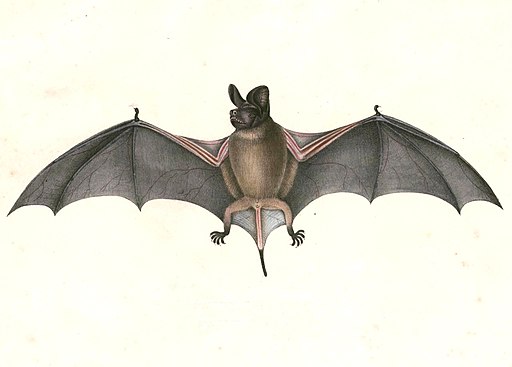Superregnum: Eukaryota
Regnum: Animalia
Subregnum: Eumetazoa
Cladus: Bilateria
Cladus: Nephrozoa
Superphylum: Deuterostomia
Phylum: Chordata
Subphylum: Vertebrata
Infraphylum: Gnathostomata
Superclassis: Tetrapoda
Cladus: Reptiliomorpha
Cladus: Amniota
Cladus: Synapsida
Cladus: Eupelycosauria
Cladus: Sphenacodontia
Cladus: Sphenacodontoidea
Cladus: Therapsida
Cladus: Theriodontia
Cladus: Cynodontia
Cladus: Mammaliaformes
Classis: Mammalia
Subclassis: Trechnotheria
Infraclassis: Zatheria
Supercohort: Theria
Cohort: Eutheria
Cohort: Placentalia
Cladus: Boreoeutheria
Superordo: Laurasiatheria
Ordo: Chiroptera
Subordo: Microchiroptera
Superfamilia: Molossoidea
Familia: Molossidae
Subfamilia: Molossinae
Genus: Chaerephon
Species: Chaerephon plicatus
Subspecies: C. p. dilatatus – C. p. insularis – C. p. luzonus – C. p. plicatus – C. p. tenuis
Name
Chaerephon plicatus Buchannan, 1800
Type locality: India, Bengal, Puttahaut.
References
Buchannan, 1800. Trans. Linn. Society of London, 5: 261.
Conservation status: IUCN: Chaerephon plicatus (Least Concern)
Chaerephon plicatus in Mammal Species of the World.
Wilson, Don E. & Reeder, DeeAnn M. (Editors) 2005. Mammal Species of the World – A Taxonomic and Geographic Reference. Third edition. ISBN 0-8018-8221-4.
Distribution
India and Sri Lanka to South China, Hong Kong, Cambodia, and Vietnam, southeast through Malyasia to the Philippines, Borneo and Lesser Sunda Islands; Hainan (China); Cocos Keeling Island (Indian Ocean)
Vernacular names
English: Wrinkle-lipped Free-tailed Bat.
The wrinkle-lipped free-tailed bat (Chaerephon plicatus) is a species of bat in the family Molossidae. It is found in Bangladesh, Bhutan, Cambodia, China, Cocos (Keeling) Islands, India, Indonesia, Laos, Malaysia, Myanmar, Nepal, the Philippines, Sri Lanka, Thailand and Vietnam.
Taxonomy and etymology
It was described as a new species in 1800 by Scottish scientist Francis Buchanan-Hamilton. Buchanan-Hamilton initially placed it into the genus Vespertilio, with the scientific name Vespertilio plicatus.[2] Its species name "plicatus" is Latin for "folded," possibly referencing its wrinkled lips or its folded ears.
Description
Its forearm length is 40–50 mm (1.6–2.0 in). Its fur is dark brown. Its dental formula is 1.1.2.32.1.2.3 for a total of 30 teeth.[3]
Range and habitat
Its range includes several countries and regions in South and Southeast Asia, including Cambodia, China, Hong Kong, India, Laos, Malaysia, Philippines, Sri Lanka, and Vietnam. It has been documented at elevations up to 950 m (3,120 ft).[1]
Conservation
As of 2020, it is evaluated as a least-concern species by the IUCN—its lowest conservation priority. It met the criteria for this classification because it has a wide geographic range; its range includes protected areas, its population size is large; and it is unlikely to be experiencing rapid population decline. However, some local populations may be threatened by overharvesting for bushmeat, habitat loss via deforestation, cave disturbance, and persecution of its roosts due to the perception that it is a pest.[1] Examples of such human interference include in northern Myanmar as a result of limestone extraction for cement manufacture[1] and colony of hundreds of thousands of bats eradicated "as pests" in Phnom Pehn.[1]
See also
List of mammals in Hong Kong
References
Csorba, G.; Bumrungsri, S.; Francis, C.; Bates, P.; Ong, P.; Gumal, M.; Kingston, T.; Heaney, L.; Balete, D.S.; Molur, S.; Srinivasulu, C. (2020). "Chaerephon plicatus". IUCN Red List of Threatened Species. 2020: e.T4316A22018444. doi:10.2305/IUCN.UK.2020-2.RLTS.T4316A22018444.en. Retrieved 16 November 2021.
Buchanan, Francis (1800). "XXVII. Description of the Vesperilio plicatus". Transactions of the Linnean Society of London. 5: 261–263. doi:10.1111/j.1096-3642.1800.tb00599.x.
Smith, Andrew T.; Xie, Yan; Hoffmann, Robert S.; Lunde, Darrin; MacKinnon, John; Wilson, Don E.; Wozencraft, W. Chris, eds. (2010). A Guide to the Mammals of China. Princeton University Press. p. 352. ISBN 978-1400834112.
Retrieved from "http://en.wikipedia.org/"
All text is available under the terms of the GNU Free Documentation License


